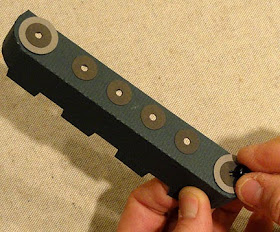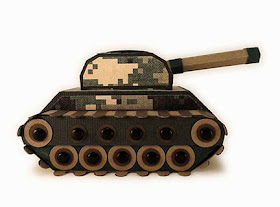Cut and build this detailed dimensional tank
which features hull accent
panels,
turret with cannon tube and hatch cover,
side caterpillar wheel boxes
and fenders,
wrap tread with individual plates.
Underneath, a base box fits
inside the shell cavity
to make this a fun gift box for cash, goodies, or gift
card.
a tootsie roll candy or hard
candy stick as the cannon.
Measures approx. 5.5" long x 4" wide x
3.25" tall.
ASSEMBLY:
1. Identify and cut the shapes:
A main hull box with accent overlays (9)
B cab box with overlays (4)
C hatch with overlay (1)
(Not shown: hatch dimension stack circles)
D cannon tube with base and end collars
(NOTE this shape is as gray in tutorial)
E wheel boxes main (2)
F wheel boxes upper boxing (2)
G fenders (2)
H wheels (14) with hub caps(22)
I lower and upper track base strips (2 ea)
J track plate overlays (44)
2. Prepare the cab shape by folding all perforations inwards except the bottom tabs on front, back and sides.
3. Align the side straight edges with each of the perforated section tab lines, one at a time, and glue tabs in place. Repeat for all four ends of the two sides.

4. Attach the cab side accent shapes (offset slightly) within the edges.
Fold the top front and back accent shapes on their perforated lines, then attach in place.
NOTE that the front shape includes edges that should line up with the cannon receptacle opening.
5. Prepare the main hull shape by folding all perforations inward.

6. Position and attach the center top accent shape to the hull.
7. Insert the cab bottom tabs into each of the corresponding slots in hull, and push the cab box down until the bottom edges seat completely flush on the hull top.

8. On the underside of the hull, press the tabs outward and glue in place.
To help attach the cab tabs completely, turn the assembly hull backside down on flat surface and apply finger pressure in the areas where the tabs are attaching underneath.
9. Fold the hull ends to line up the section tabs with their respective straight edges on the hull sides and glue each in place, one at a time.
Repeat for all four ends of the hull sides.
10. Fold the bottom hull flanges into the box interior and glue each in place to create the opening's rim.
11. Prepare the two wheel box main shapes by folding the sides inward, end tabs inward.
12. Prepare the separate top wheel box boxing strips by folding the ends inward - this will almost resemble "curling" the ends. Also fold the side tabs inward.
13. Attach one end straight edge of the top boxing strip to overlap one main wheel bo end tab to perforation line. (It doesn't matter which ends are attached first - they are interchangeable.)
Repeat for second wheel box assembly.
14. Bend the boxing strip to align unattached end with opposite box tab and attach as with the first, for both box assemblies.
15. Apply glue to the boxing tab area for the outside (whole shape with punch holes) of the wheel box assembly.
Fold the front side into place to line up and attach all edges with corresponding segments of the boxing.
NOTE: it may be helpful to line up the long top tab and edge, then the lower side longer tabs and edges, then work to get the "curved" segments areas to conform to the side edges.
16. Fold the back panel of the wheel box into position on the boxing tabs, in a manner similar to what was done for the front panel. Apply glue, align edges with section tab perforations as before, then attach.
Use the finger access cutout in the back panel to reach in and assist with the alignment and to apply pressure to attach tabs and panel.

17. Prepare the fender shapes by folding inward on all perforation lines.
18. Bend the ends inward to line up the front panel straight edge segments with corresponding boxing tab perf lines. Adjust for final positioning and glue in place. Complete both ends of the two fender assemblies.
19. Prepare 14 wheels by centering and attaching smaller hub cap circles to larger wheel circles (gray in this sample).
20. On each fender, position and attach two wheels on ends, with four hub cap circles between, as shown.
Insert and attach decorative brads in all positions.
(You may substitute "backless" studs over the hole punches, as desired. These can be attached at this point in assembly, or later.)
21. Position and attach five wheel assemblies over the hole punches on each of the wheel boxes. Add brads at this point in assembly (while inside of box can be accessed).
22. Slide fender over top (widest end) of wheel box and glue upper surfaces together where they touch.
Repeat for both wheel box assemblies.
23. Insert fender tabs into corresponding slots on main hull.
On the inside of the hull . . .

. . . bend the tabs upward and glue in place securely.
(This needs to be a very flush attachment for all interior tabs so that the base box can slide into place appropriately.)
24. Apply glue to the inner surface of wheel box, then bend it into position so that those inner surfaces contact the sides of the main hull. Hold in place and apply pressure as possible, until securely attached.
Repeat for both wheel boxes.
NOTE: This image shows the same liquid glue being used for this critical attachment as has been used for the other assembly. However, I recommend using a thin scribble of clear hot glue applied quickly to the inner box surface, then positioned and held in place until the glue cools and attaches.
25. Attach remaining accent shapes to sides, front and back of the hull.
26. Prepare the long track strip by adding curl to each end.
You can add curl by applying pressure between thumb and finger as you pull the strip through and downward - thing curling ribbon.
26. Attach short strip to end of long strip by overlapping straight edge at tab perforation.
Repeat for both strip pairs.
27. Position the track short strip on the bottom of the wheel box, straight edge inward as shown, with end perforation or seam lined up with ends of bottom box ends. Glue in place.
Repeat for the other wheel box.
28. Wrap the long track strip over the top of the wheel box to bring the opposite free end to meet the short end tab. Line up straight end at tab perf line and glue in place.
Apply adhesive between the top of the wheel box and the underside of the track to help hold it in place.
29. Attach each track plate in position on the track strips so that rounded ends align with "bump outs" and straight ends align with straight edge of track strip.

30. Prepare the cab hatch by attaching accent circle on top.
Glue the 4 dimension circles (more if desired) into a stack, then attach to the center underside of the hatch.

31. Position and attach the hatch shape on top of the cab, as shown (handle toward back).
32. Prepare the cannon tube shape by carefully folding inward on all long perforation lines. Also fold end tabs and attached hex inward.
33. Form the cannon into a tube to bring the straight long edge to overlap the opposite long tab. Apply adhesive, adjust edge and tab, and glue in place.
It may be helpful to insert a rod shape such as the dowel shown here, or a standard school pencil shaft, to provide a rigid "press-against" surface to join the seam.

34. Apply glue to the underside of attached hex, fold the top end tabs inward, with the hex on top, adjust so edges line up, then hold in place until secure.
35. Fold the end and base collars on perforation lines. Also fold the base top edge tabs back and glue in place.
Apply glue to end collar underside, then wrap around cannon tube, adjust, and glue in place.
The same process is followed for the base collar. However, you will want to insert the cannon into the cab hole, push in to the desired depth (our model has the tube inserted until it rests against both the cab back and the hull roof) to know where to place the base collar.
(See next image.)
36. Insert cannon into cab at your preferred depth, then attach collar as close to the cab as possible.
If you intend your cannon tube to remain permanently in place, also apply glue to the end to be inserted, and as neatly as possible to the bottom only of the cab hex opening.
37. Prepare the base box shape by folding ends and sides upward, rim and end side tabs inward.
38. Build the box by gluing adjacent straight side edges to end tabs.
Fold the upper edge tabs inward and glue to the inside surfaces of the box.
Insert the box into the bottom cavity as shown.
Here is the completed tank.
Finally, a few images of the completed tank project,
for reference as you plan and finish yours.




































My boys love this and are asking me to make them one. Can you tell me where you found the camo cardstock and what size brads you used?
ReplyDeleteGlad you have boys who attend to creative things you do. The camo cardstock I purchased from my local scrapbook store, Heartfelt Creations in Sandy, Utah. The card product info: Camouflage - Green #35562 from Scrapbook Customs (www.scrapbookcustoms.com). The brads are slightly larger than 1/4" head diameter.
ReplyDeleteThis is really neat. I just made one and I didn't have any camo so I used patriotic card stock. It still looks neat.
ReplyDeleteThis was so easy and fun to assemble Jodi :-) The boys love it :-)
ReplyDelete